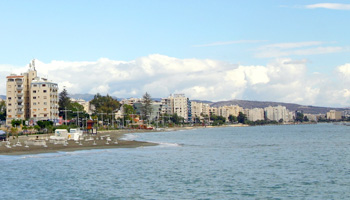ICE FT 02 | Contourites and Reworked Turbidites From the Eocene to Miocene Deposits of the Lefkara and Pakhna Formations (Cyprus): Scientific and Economic Significance
American Association of Petroleum Geologists (AAPG)
Wednesday, 11 October – Friday, 13 October 2017, 9:00 a.m.–7:00 p.m. | Limassol, Cyprus
Who Should Attend
Geologists, marine geologists, sedimentologists, and paleoceanographers interested in learning about bottom current processes and products and their importance in shaping the seafloor morphology and in controlling the sedimentary stacking pattern on continental margins and abyssal plains.
Objectives
During this field trip we will visit key field localities that showcase some of the best known examples of ancient bottom current deposits in the Lefkara and Pakhna Formations (Cyprus). Sedimentary facies, ichnological information, microfacies and sedimentary models will be discussed and associated with analogue deposits in modern / recent deep-water environments. These deposits will be compared to other deep-water deposits (as reworked turbidites, turbidites, mass transport and pelagic/hemipelagic deposits) in the same outcrops and their conceptual and economic significance will be discussed.
Course Content
This three-day field trip is organized by the “Drifters Research Group” (Royal Holloway University of London, UK) and the Cyprus Geological Survey.
Bottom currents and their deposits (contourites) are now widely recognised as a major component of continental margin and abyssal plain sedimentation throughout the world oceans. Contourites and other features generated by bottom currents (depositional, erosional or mixed), provide strong diagnostic evidence for both modern and ancient bottom-water circulation patterns and associated sedimentary processes, which have proven to critically control the morphology of continental margins. They offer important insights into the sedimentary evolution of the continental margins, and have significant potential for marine geohazards. Sandy contourites and mixed turbidite-contourite deposits can form extensive sand-rich deposits in deep-water settings, which provide a play for hydrocarbon reservoirs, already proven in several key discoveries. Deep-water sandy deposits generated or affected by bottom currents are still poorly known, especially from the ancient record in outcrop, however they should be explored and evaluated, since these deposits are of great scientific and economic significance. The proposed field trip will provide an opportunity to: (a) visit three field localities with clear evidence of bottom current activity. The outcrops consist of sand and mud-rich calci-contourites, and reworked turbidites, within the Eocene-Miocene Lefkara and Pakhna Formations (Southern Cyprus); (b) attend a short programme of lectures on bottom-water circulation, contourite deposits and other features at varying geological scales (outcrop to regional-scale), from key contourite contributors; and (c) participate in lively discussion sessions on bottom current processes and products and evaluate their scientific and economic significance.
Field Trip Collaborators
Adam Creaser (RHUL, UK)
Dr. Estefanía Llave Barranco (Spanish Geological Survey, Spain)
Dr. Domenico Chiarella (RHUL, UK)
Antoine Thieblemont (RHUL, UK & TOTAL, France)
Sandra de Castro (RHUL, UK)
Wouter de Weger (RHUL, UK)
Itinerary Roster
Wednesday, 11 October
09:00-10:00: Introduction: Geology of Cyprus, the Circum Troodos Sedimentary Succession
10:00: Travel to Petra tou Romiou section
- Stop 1 — The Triassic volcanic rocks (Fassoula Formation) of the Dhiarizos group, which belong to the Mammonia Terrane, overlooking Aprhodites Bay
- Stop 2 — Lefkara Formation. Beach outcrop. Lower part of the section with distal and deep-water deposits. Chalks, fine grained turbidites, bottom current deposits.
- Stop 3 — Lefkara Formation. Road B6. Cherts, chalks, turbidtes, mass transport and bottom current deposits.
- Stop 4 — Pakhna Formation. Road B6 1st package of sandy contourites (calcarenites). Reworked turbidites and marls.
Lunch time
- Stop 5 — Pakhna Formation Road B6. 2nd package of sandy contourites (calcarenites). Reworked turbidites, mass transport deposits, and marls.
- Stop 6 — Pakhna Formation. Upper part of the section with more proximal and shallow-water deposits
16:30: Travel back to venue
18:00 – 20:00: Evening sessions:
- Bottom current processes
- Bottom current products
Thursday, 12 October
09:00: Travel to Agios Nicolaos section
- Stop 1 — Lefkara Formation. Agios Nicolaos section. Oceanic crust and the lower part of the section with distal and deep-water deposits. Chalks, cherts, fine grained turbidites.
- Stop 2 — Lefkara Formation. Zenon section. Cherts, chalks, turbidites, mass transport deposits.
Lunch time
Stop 3 — Pakhna Formation. Agios Konstantinos section. Packages of sandy contourites (calcarenites). Reworked turbidites, mass transport deposits, and marls.
16:00: Travel back to venue
18:00 – 20:00: Evening sessions:
- Bottom current deposits in Cyprus
- Offshore analogues
Friday, 13 October
09:00: Travel to Kalavasos section
- Stop 1 — Pakhna Formation. Kalavasos section. Packages of sandy contourites (calcarenites). Reworked turbidites, mass transport deposits,and marls.
Lunch time
14:00: Travel back to venue
16:00 – 19:00: Afternoon / evening sessions:
- Ichnology from bottom current deposits in Cyprus
- Microfacies from bottom current deposits in Cyprus
- Final discussion
Fees
Professionals: US $940 + 20% VAT
Students: US $740 + 20% VAT
Limit: 30 people
Includes: Accommodations (single occupancy), local transports and meals.
Does not include: Travel to and from Cyprus.
Notes: Bus transportation will be organised from the airport to Lemesos on the evening of the 10 October and from Lemesos to the airport in the early morning on 14 October. Information about this transportation will be distributed in due time.
We can book the travel for participants (optional) from London Heathrow / Gatwick Airport to Larnaka / Paphos and return. Tentative price is US $430.
Field boots, sun hat (wide brimmed), sunscreen and light waterproofs (in case if rain). Be ready for possible cold conditions during the second field trip day. High-visibility (for roadside activities) will be provided. Participants should bring any additional PPE required by their employers.
Venue

Limassol, Cyprus
Limassol,
Ammochostos
Cyprus